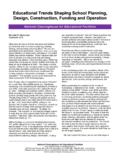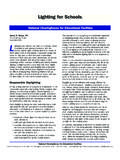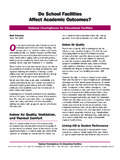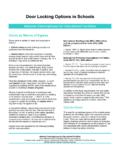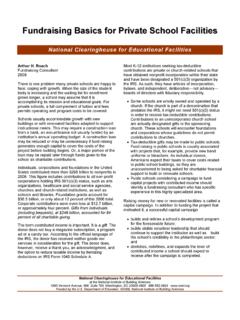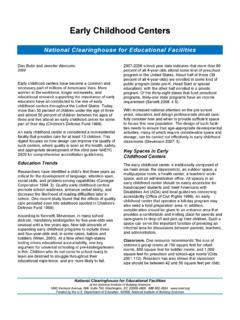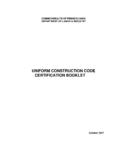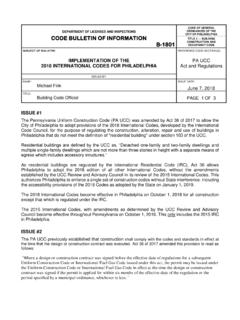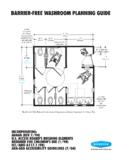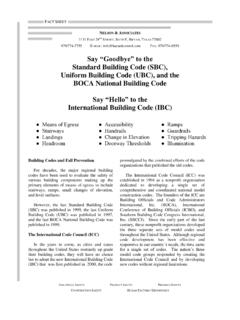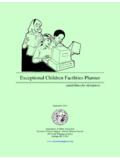Transcription of Creating Accessible Schools - NCEF
1 National Clearinghouse for Educational Fa c i l i t i e sNational Clearinghouse for Educational Fa c i l i t i e s1090 Vermont Avenue, , Suite 700, Washington, 20005 4905 (888) 552 0624 www. e d f a c i l i t i e s . o r gCreating Accessible SchoolsJames Ansley ADAPT Associates 2000, National Institute of Building SciencesAfter three decades of legislation and litigation,America s public Schools are opening their doors tochildren with disabilities. Inclusive Schools arebecoming the norm, and equal educational opportunity isnow the right of every child. Successfully preparing chil-dren who are disabled in company with their nondisabledclassmates for full participation in American society firstrequires that we make our Schools of both the context and the complexity ofaccessibility should inform the efforts of all engaged in thedevelopment and operation of our Schools .
2 Accessibility sgoal is larger than building barrier-free structures, and itsachievement is far more challenging than simply adheringto standards and codes. The following discussion, focusingon accessibility as it applies to school facilities, is intendedto provide a systematic overview of issues bearing on whatis recognized by many as a formidable i s t o r i c a l l y, the educational experience of children with disabilities was characterized by neglect, inequity, and mistreatment. Prior to the 1970s, most physically andmentally disabled students were, in fact, excluded frompublic Schools or were not identified as disabled (Otto1998, p. 9). Where programs and facilities did exist toserve disabled children, they tended to be centralized andsegregated. While the educational advantages of neighbor-hood Schools were touted on behalf of able-bodied students, those with disabilities were often bussed enmasse to special rationale behind Schools for the handicapped lay inthe contention, often sustained by expert opinion, thatseparate, specialized Schools were inherently better suitedto disabled children s educational needs than were conven-tional Schools .
3 As a result, public Schools throughout long remained ill-equipped and generally unpreparedto accommodate and educate students with Supreme Court s decision in Brown v. Board ofE d u c a t i o n(347 483 (1954)) had far reaching implications for the education of disabled students and "permeated future legislation and social thinking regardingthe rights of qualified disabled students to have accessibleand usable facilities (Otto p. 10). Conveying a unanimousCourt s opinion, Chief Justice Warren s words would serveall children: We conclude that in the field of public Navigation AidesABA Architectural Barriers Act of 1968 (PL 90-480)Access Board The Architectural andTransportation Barriers Compliance BoardADA Americans with Disabilities Act of 1990 (PL 101-3 3 6 )ADAAG ADA Accessibility Guidelines for Buildings andFacilities (advisory only)ADA Standards ADA Standards for Accessible Design(legally enforceable)CFR Code of Federal RegulationsFAPE free appropriate public education IDEA Individuals with Disabilities Education Act of 1990(PL 101-476), an amended and renamed version of theEducation for All Handicapped Children Act of 1975 (PL9 4 - 1 4 2 )IEP individualized education program LRE least restrictive environment MGRAD Minimum Guidelines and Requirements forAccessible Design (advisory only)
4 OSEP Office of Special Education Programs, of Education PARC Pennsylvania Association for Retarded Children v. Pennsylvania(a court decision)Section 502, Section 504 sections of Title V of theRehabilitation Act of 1973 (PL 93-112)UFAS Uniform Federal Accessibility Standards (legallye n f o r c e a b l e ) Creating Accessible SchoolsNational Clearinghouse for Educational Fa c i l i t i e s1090 Vermont Avenue, , Suite 700, Washington, 20005 4905 (888) 552 0624 www. e d f a c i l i t i e s . o r gCreating Accessible Schoolseducation the doctrine of separate but equal has no educational facilities are inherently unequal."In the early 1970s, two Federal District Court decisions,Pennsylvania Association for Retarded Children e n n s y l v a n i a(334 F. Supp. 1247 ( Pa. 1971)) andMills v. Board of Education of the District of Columbia (348 F.)
5 Supp. 866 (D. 1972)), recognized that children with disabilities are guaranteed an equal opportunityto an education under the Fourteenth Amendment of Constitution. These cases were filed through theefforts of parent advocates and were based on the equalprotection arguments used in the landmark desegregationcase of Brown v. Board of Education. This litigation wasinstrumental in Congress s enactment of legislation that provided children and youth with disabilities with a federallyprotected civil right to a free and appropriate public educa-tion for the first time (Rangel-Diaz 2000, pp. 1 2).Educational practice under law now requires public schooldistricts to exert deliberate effort to identify and evaluatechildren with disabilities and to educate them within regularclassrooms. The effect on public Schools across the been profound. Enrollment of children with disabilitiesrose from percent of all children served by publicschools in 1977 to 12 percent in 1996 (Kennedy 1999).
6 To d a y, 75 percent of America s six million students with disabilities are being educated in the general educationclassroom (National Education Association 1997, p. 3). Exceptions to the legal mandate for primary placements(where students receive 50 percent or more of their instruc-tion) in the regular classroom are permitted only when achild s individual educational needs will clearly be better metin another setting, such as a classroom designated for special education purposes or an external Schools , including carefully designed residentialfacilities, have continued to play a necessary role, albeit achanging one, in meeting certain of the educational needsof children and youth with disabilities (Forcier 1999). In fact,although the percentage of students requiring special educa-tion who are placed in residential Schools has remaineds t e a d y, in some states these Schools are experiencing sub-stantial enrollment increases.
7 This may be due both toimprovements in the early identification of children withproblems and to the recent increase in the number ofschool-age children in the general population, an increasethat will persist well into the coming decade (Souter 1999).Although not all of the nation s six million K 12 studentswith disabilities require special education, the NationalResearch Council reports that more than five million of thispopulation do qualify. Of this number needing special educa-tion, the Council notes that more than 90 percent fall intoone of just four categories of disability: speech or languageimpairment, serious emotional disturbance, mental retarda-tion, and specific learning disability and that specific learning disabilities account for more than half of all eligible students (McDonnell, McLaughlin, and Morison 1997, p. 23). These facts also highlight the necessity of addressingstudents cognitive as well as physical accessibility needs;h o w e v e r, cognitive components of accessibility to the cur-riculum are outside the intended scope of this spite of the influx of students with disabilities into generaleducation classrooms, the General Accounting Office (1995)reports that no national survey of school accessibility hasbeen done or is being planned by the Departments ofJustice or Education or by the Access Board and that thebiennial school survey by the Department of Education sOffice for Civil Rights has not included questions on facilities accessibility since the late 1970s (p.)
8 13). A study conduct-ed by the GAO itself disclosed that Schools physical acces-sibility varied enormously (p. 24) and that, although schoolsin every state reported spending on accessibility during thethree years preceding the inquiry, the amounts varied widely (p. 16). Of the Schools reporting accessibility spend-ing, the average amount per school was $40,000, with 80percent of Schools spending less ($8,000 on average) and20 percent spending more. The 20-percent group, fre-quently larger Schools and those situated in the Northeast,accounted for 84 percent of the total reported participating Schools estimated that during the three-year period following the study, they would need to spendapproximately triple what had been spent on accessibilityduring the preceding three officials participating in the GAO study said that theycould not make Schools Accessible because of lack of fund-ing and that money spent on accessibility may be unrea-sonable or at the expense of other areas (p.
9 25). In con-trast, Ratzka (1991) provides an economist s perspective: The only way to enforce Accessible construction is throughstate imposed norms as in the case of fire protection. Similarto fire protection, investments in accessibility measures arehighly profitable for society. The costs of Accessible construc-tion are low in relation to the expected returns (p. 9).Apart from the persistent contention that special Schools arebetter suited to disabled children s needs, much of theresistance to placement of students with disabilities intoconventional settings has been rooted in the lack-of- f u n d i n gclaim, which the courts have rejected. The community ofpersons with disabilities has responded by asking, Whatother group at disadvantage in present-day American societywould abide the notion that the rights of its members, especially children, are anything but priceless?
10 2 Creating Accessible Schools3 National Clearinghouse for Educational Fa c i l i t i e s1090 Vermont Avenue, , Suite 700, Washington, 20005 4905 (888) 552 0624 www. e d f a c i l i t i e s . o r gLaws and EnforcementA succession of federal and state laws now entitles childrenand youth with disabilities to free appropriate public educa-tion along with students who are nondisabled. Althoughthese laws may differ in their scope and emphasis and atpoints may overlap, their common effect with respect toschool facilities has been to foster inclusive and normalizededucational environments for Americans with Disabilities Act of 1990, also referred toas the ADA (PL 101-336), is the nation s best known andmost encompassing disability-rights legislation. Well beforepassage of the ADA, however, educators had become con-versant with an evolving legal framework bearing on therights of students with disabilities.

